Annual Report of the Intellectual Property Court of the Supreme People's Court (2019) | | 最高人民法院知识产权法庭年度报告(2019) |
| (2020) | | (2020年) |
| Introduction | | 前 言 |
| Since the 18th National Congress of the Communist Party of China (CPC), the Central Committee of the CPC with President Xi Jinping as the core leader has actively implemented an innovation-driven development strategy, attached immense importance to intellectual property rights protection, and made major strategic decisions and arrangements for the establishment of the Intellectual Property Court of the Supreme People's Court (hereinafter referred to as “the IP Court”) to build China into an IP power and a science and technology power in the world. On January 1st, 2019, the IP Court was officially unveiled and became the first specialized IP court at the highest court level worldwide. The IP Court exercises final instance judicial function by hearing appeals on patents, monopoly, and other technology-related IP cases from across China. It also undertakes the responsibilities and mission to further unify judicial standards for technology-related IP cases, improve the quality and efficiency of trials, enhance judicial trustworthiness and international influence, and provide judicial guarantees for strengthening innovation-driven development strategies and the implementation of national intellectual property strategies. | | 十八大以来,以习近平同志为核心的党中央大力实施创新驱动发展战略,高度重视知识产权保护,从建设知识产权强国和世界科技强国的战略高度,作出设立最高人民法院知识产权法庭(简称“法庭”)的重大战略决策部署。2019年1月1日,法庭正式揭牌成立,成为世界范围内首个在最高法院层面设立的专门化知识产权审判机构,行使统一审理全国范围内专利、垄断等技术类知识产权上诉案件的终审职能,承担进一步统一技术类知识产权案件裁判尺度、进一步提高审判质量和效率、进一步提升司法公信力和国际影响力、进一步为加强创新驱动发展战略和国家知识产权战略实施提供司法保障的职责使命。 |
| Since its establishment, guided by the Xi Jinping Thought on Socialism with Chinese Characteristics for a New Era, the IP Court has comprehensively implemented the decisions formulated at the 19th National Congress of the CPC, and the second, third and fourth plenary sessions of the 19th Central Committee of the CPC, enhanced the “Four Consciousnesses”, fostered “Four Matters of Confidence”, and ensured “Two upholds”. Focusing on the duties and missions entrusted by the Party Central Committee, the IP Court actively seeks a holistic approach at the highest judicial level to both the domestic and international situations, focusing on the “high starting point, high caliber, high level, and international standards” and adhering to the court motto of “Innovation, Perseverance, Prudence, and Preeminence,” and continues to deepen reforms in the field of technology-based intellectual property trials and gives full play to the function of technology-related intellectual property trials to stimulate and protect innovation and to promote scientific and technological progress and social development, so as to safeguard and serve the overall national economic and social development, to contribute Chinese experience and wisdom in the formulation of international intellectual property protection practice and rules, and to strive to promote open, inclusive, balanced, and effective development of international intellectual property rules and governance systems. | | 自成立以来,法庭始终坚持以习近平新时代中国特色社会主义思想为指导,全面贯彻落实党的十九大和十九届二中、三中、四中全会精神,切实增强“四个意识”、坚定“四个自信”、做到“两个维护”。围绕党中央赋予的职责使命,积极在最高司法层面统筹国内国际两个大局,坚持“高起点、高标准、高水平、国际化”标准,秉持“创新、精进、智慧、卓越”庭训,不断深化技术类知识产权审判领域改革,充分发挥技术类知识产权审判激励和保护创新、促进科技进步和社会发展的职能作用,保障和服务国家经济社会发展大局,并在知识产权国际司法保护实践和规则形成中贡献中国经验和中国智慧,努力推动知识产权国际规则和治理体系朝着开放包容、平衡有效的方向发展。 |
| Ⅰ. Focus on the function of trial to strengthen typical exemplary effect of model cases and further unify the standards for adjudicating technology-related IP cases | | 一、立足审判职能,加强典型示范,进一步统一技术类知识产权案件裁判尺度 |
| Unifying the standards for adjudicating patent and other technology-related IP cases is the primary goal of the IP Court. In 2019, the IP Court focused on the function of trial and concluded a number of closely technology-related IP cases justly and efficiently in accordance with the law. A number of model judgments that have typical exemplary effect were made, and the “systematization project to unify judicial standards” has been implemented, further promoting the unification of judicial standards for technology-related IP cases. | | 统一专利等技术类知识产权案件裁判标准,是法庭设立的重要目标。2019年,法庭立足司法审判职能,依法公正高效审结了一批专业技术性较强的知识产权案件,形成了一批具有典型示范作用的标杆性判决,建设实施“统一裁判标准系统工程”,进一步推动了技术类知识产权案件裁判尺度的统一。 |
| 1. Focus on the function of trial to try cases fairly | | (一)立足审判职能,公正审理案件 |
| In 2019, the IP Court accepted a total of 1,945 technology-related IP cases and concluded 1,433 cases, with a closing rate of 73.7%. Among the newly accepted cases, 962 were civil substantive cases of second instance, of which 586 were concluded; 241 were administrative cases of second instance, of which 142 were concluded; 481 were challenge to jurisdiction cases of second instance, of which 446 were concluded; and 261 were other types of cases, of which 259 were concluded. | | 2019年,法庭共受理技术类知识产权案件1945件,审结1433件,结案率73.7%。其中,受理民事二审实体案件962件,审结586件;受理行政二审案件241件,审结142件;受理管辖权异议二审案件481件,审结446件;受理其它类型案件261件,审结259件。 |
 | | 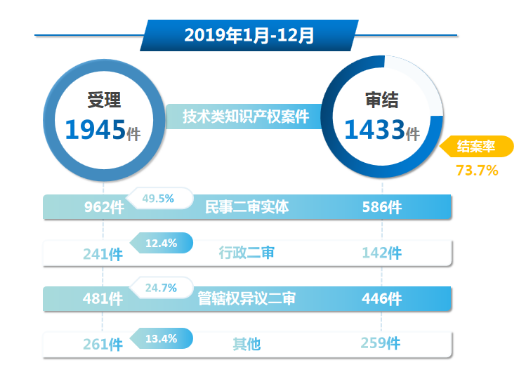 |
| (1) Statistical analysis of the cases | | 1.案件数据统计分析 |
| ① Statistical analysis of the source of cases | | (1)案件来源统计分析 |
| In 2019,the IP Court accepted a total of 1,684 various types cases of second instance. Among them, 1,678 were appealed against judgments made by Intermediate People's Courts in the first instance, accounting for 99.6%; and 6 were appealed against judgments made by High People's Courts in the first instance, accounting for 0.4%. | | 2019年,法庭共受理各类二审案件1684件。其中,一审法院为中级人民法院的为1678件,占比99.6%,一审法院为高级人民法院的为6件,占比0.4%。 |
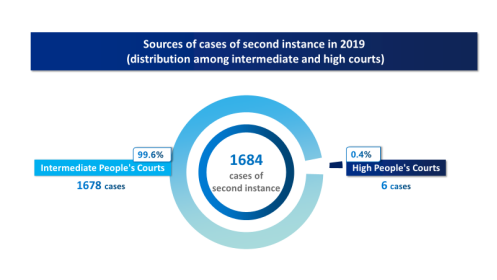 | | 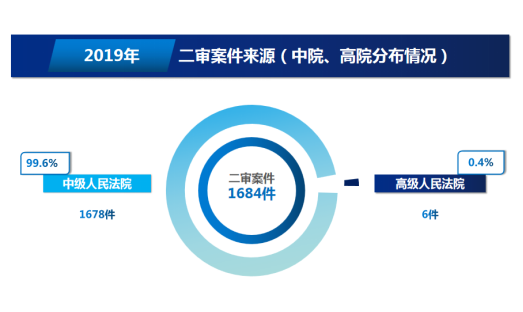 |
| In terms of the source regions of the cases, the top ten include: Beijing Intellectual Property Court (376 cases), Guangzhou Intellectual Property Court (297 cases), Shanghai Intellectual Property Court (143 cases), Nanjing Intellectual Property Tribunal (107 cases), Shenzhen Intellectual Property Tribunal (96 cases), Ningbo Intellectual Property Tribunal (85 cases), Suzhou Intellectual Property Tribunal (71 cases), Hangzhou Intellectual Property Tribunal (70 cases), Qingdao Intellectual Property Tribunal (67 cases), and Jinan Intellectual Property Tribunal (53 cases). The above data roughly reflect the distribution of technology-related IP disputes across the country. It is clear from the above data that economically developed regions tend to have more economic activities involving technology-related intellectual property and accordingly, there are more related disputes. | | 就案源地区分析,案件排名前十位的分别为北京知识产权法院(376件)、广州知识产权法院(297件)、上海知识产权法院(143件)、南京知识产权法庭(107件)、深圳知识产权法庭(96件)、宁波知识产权法庭(85件)、苏州知识产权法庭(71件)、杭州知识产权法庭(70件)、青岛知识产权法庭(67件)、济南知识产权法庭(53件)。上述数据大致反映出技术类知识产权纠纷在全国的分布情况,并表明:越是经济发达地区,涉技术类知识产权的经济活动越活跃,相关纠纷也越多。 |
 | |  |
| ②Statistical analysis of the types of cases accepted | | (2)案件类型统计分析 |
| Among the 962 civil substantive cases of second instance accepted by the IP Court, there were 454 disputes over infringement of utility model patent rights, 234 disputes over infringement of invention patent rights, 142 disputes over computer software, 40 disputes over patent agency and licensing contracts, 26 disputes over technical contracts, 20 disputes over new plant variety rights, 12 disputes over technical secrets, 9 disputes over monopoly, 9 disputes over patent application rights and patent ownership, 8 disputes over confirmation of non-infringement, 7 disputes over remuneration to service inventors, and 1 dispute over layout design of integrated circuits. The majority of the cases are disputes over infringement of utility model patent rights (47.2%), disputes over infringement of invention patent rights (24.3%), and disputes over computer software (14.8%). | | 在法庭受理的962件民事二审实体案件中,侵害实用新型专利权纠纷454件,侵害发明专利权纠纷234件,涉计算机软件纠纷142件,涉专利代理、许可合同纠纷40件,技术合同纠纷26件,涉植物新品种权纠纷20件,涉技术秘密纠纷12件,涉垄断纠纷9件,专利申请权及专利权权属纠纷9件,涉确认不侵权纠纷8件,涉职务发明人报酬纠纷7件,涉集成电路布图设计纠纷1件。其中,占比较高的纠纷类型分别为侵害实用新型专利权纠纷(47.2%)、侵害发明专利权纠纷(24.3%)、涉计算机软件纠纷(14.8%)。 |
 | |  |
| Among the 241 administrative cases of second instances accepted by the IP Court, there are 230 cases of administrative grant and affirmation, 7 administrative penalty cases, and 4 other administrative cases. Among the cases of administrative grant and affirmation, there are 80 administrative disputes over invalidation of patent rights, 71 administrative disputes over reexamination of invention patent applications, 57 administrative disputes over invalidation of utility model patent rights, 9 administrative disputes over reexamination of utility model patent applications, and 13 administrative disputes over invalidation of design patent rights. The majority of the cases are administrative disputes over invalidation of invention patent rights (33.2%), administrative disputes over reexamination of invention patent applications (29.5%), and administrative disputes over invalidation of utility model patent rights (23.7%). | | 在法庭受理的241件行政二审案件中,行政授权确权类案件230件,行政处罚类案件7件,其他行政案件4件。在行政授权确权类案件中,发明专利权无效行政纠纷80件,发明专利申请驳回复审行政纠纷71件,实用新型专利权无效行政纠纷57件,实用新型专利申请驳回复审行政纠纷9件,外观设计专利权无效行政纠纷13件。其中,占比较高的纠纷类型分别为发明专利权无效行政纠纷(33.2%)、发明专利申请驳回复审行政纠纷(29.5%)、实用新型专利权无效行政纠纷(23.7%)。 |
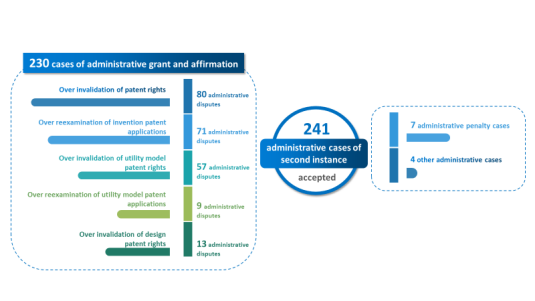 | |  |
| ③ Statistical analysis of judgment results | | (3)裁判结果统计分析 |
| In 2019, the IP Court concluded a total of 1,174 cases of second instance. Among them, 731 cases were concluded with the decisions of the first instance being affirmed; 280 cases were concluded with the appeals being withdrawn, 71 cases were concluded through mediation, with the mediation and withdrawal rate of 29.9%; and 92 cases were concluded by either being sent back for retrial or reversal of decisions on appeal, with the send back and reversal rate of 7.8%. Of the 92 send back for retrial or reversal cases concluded by the IP Court, there were 66 civil substantive cases of second instance, 21 cases of second instance on challenge to jurisdiction, and 5 administrative cases of second instance. | | 2019年,法庭共审结二审案件1174件。其中,以维持原审裁判方式结案的为731件,以撤诉方式结案的为280件,以调解方式结案的为71件,调撤率为29.9%,以发改方式结案的为92件,发改率为7.8%。法庭发改的92件案件中,民事二审实体案件66件,管辖权异议二审案件21件,行政二审案件5件。 |
 | |  |
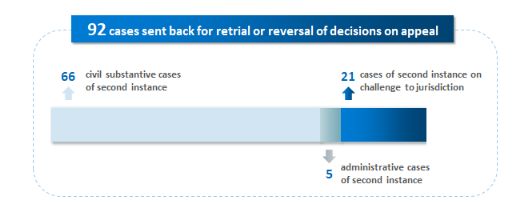 | | 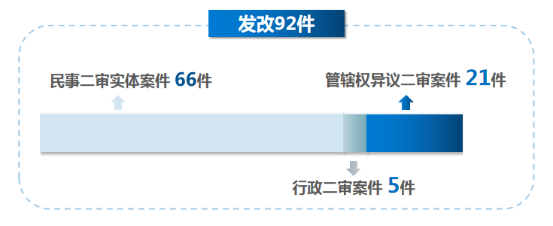 |
| Of the 586 civil substantive cases of second instance concluded by the IP Court, 236 were concluded with the decision of the first instance being affirmed; 213 cases were concluded with the appeals being withdrawn, 71 cases were concluded through mediation, with the mediation and withdrawal rate of 48.5%; and 66 cases were concluded by either being sent back for retrial or reversal of decisions on appeal, with the send back and reversal rate of 11.3%. | | 在法庭审结的586件民事二审实体案件中,以维持原审裁判方式结案的为236件,以撤诉方式结案的为213件,以调解方式结案的为71件,调撤率为48.5%,以发改方式结案的为66件,发改率为11.3%。 |
| Of the 142 administrative cases of second instance concluded by the IP Court, 126 cases were concluded with the decision of the first instance being upheld; 11 cases were concluded with the appeals being withdrawn; and 5 cases were concluded by reversal of decisions on appeal, with the reversal rate of 3.5%. | | 在法庭审结的142件行政二审案件中,以维持原审裁判方式结案的为126件,以撤诉方式结案的为11件,以改判方式结案的为5件,改判率为3.5%。 |
| Of the 446 cases of second instance on challenge to jurisdiction concluded by the IP Court, 369 cases were concluded with the decisions of the first instance being affirmed; 56 cases were concluded with the appeals being withdrawn; and 21 cases were concluded by reversal of decisions on appeal, with the reversal rate of 4.7%. | | 在法庭审结的446件管辖权异议二审案件中,以维持原审裁判方式结案的有369件,以撤诉方式结案的有56件,以撤改方式结案的有21件,撤改率为4.7%。 |
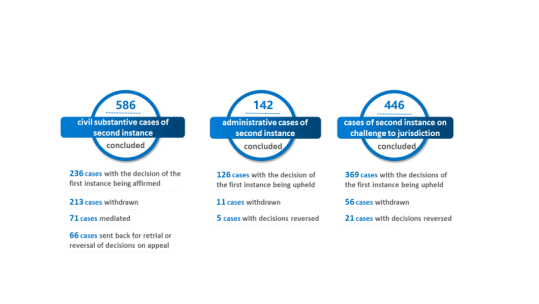 | | 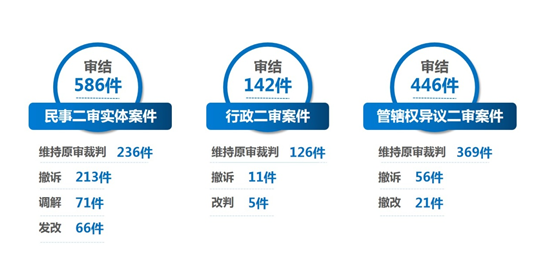 |
| ④ Statistical analysis of trial period | | (4)审理周期统计分析 |
| In 2019, the average trial period for substantive cases of second instance tried by the IP Court was 73 days, and 29.4 days for cases of second instance on challenge to jurisdiction. The closing rate was 39.2 cases per judge. | | 2019年,法庭二审实体案件平均审理周期为73天,管辖权异议二审案件平均审理周期为29.4天。法官人均结案39.2件。 |
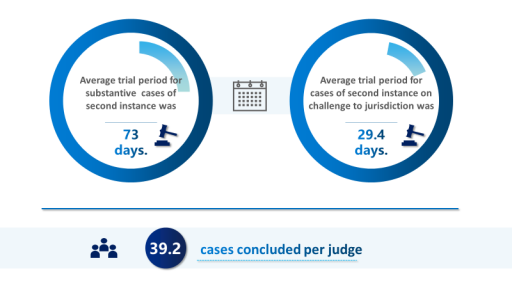 | | 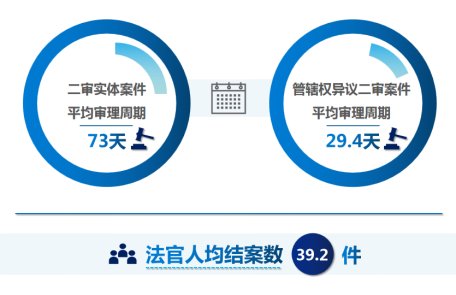 |
| ⑤ Statistical analysis of cases involving a party from foreign country, Hong Kong, Macau, and Taiwan Region | | (5)涉外、涉港澳台案件统计分析 |
| In 2019, the IP Court accepted 174 cases involving a party from foreign country, Hong Kong, Macau, and Taiwan region. Among them, there were 50 civil substantive cases of second instance, 52 administrative cases of second instance, 71 cases of second instance on challenge to jurisdiction, and 1 other case. By region, there were 75 cases involving EU countries, 54 cases involving the United States, 15 cases involving Japan, 4 cases involving South Korea, 2 cases involving Canada and Israel, respectively, 1 case involving Australia and South Africa, respectively, and 20 cases involving Hong Kong, Macau and Taiwan. | | 2019年,法庭共受理174件涉外、涉港澳台案件。其中,民事二审实体案件50件,行政二审案件52件,管辖权异议二审案件71件,其他案件1件。按地域统计,涉欧盟国家75件,涉美国54件,涉日本15件,涉韩国4件,涉加拿大、以色列各2件,涉澳大利亚、南非各1件,涉港澳台20件。 |
| The IP Court concluded 98 cases involving a party from foreign country, Hong Kong, Macau, and Taiwan region. Among them, 35 substantive cases were concluded, of which 21 were won by foreign parties (including partially won), 3 were won by Hong Kong, Macao and Taiwan parties, and 11 were won by parties of the Chinese mainland. | | 法庭共审结98件涉外、涉港澳台案件。其中,审结的实体案件为35件,外方当事人胜诉(包括部分胜诉)21件,港澳台方当事人胜诉3件,内地当事人胜诉11件。 |
 | |  |
| (2) Case characteristics analysis | | 2.案件特点分析 |
| ① Overall characteristics of cases | | (1)整体案件特点 |
| In 2019, technology-related IP cases tried by the IP Court share the following characteristics: they involve a wide range of technologies; they have a large social impact; many of them involve interconnected procedures; the trial period is short; the legitimate rights and interests of Chinese and foreign parties are equally protected; and the direction for increasing the judicial protection is clear. | | 2019年,法庭审理的技术类知识产权案件在整体上具有以下特点:涉及技术领域广,社会影响大,程序交织案件多,审理周期短,平等保护中外当事人的合法权益,加大司法保护力度的导向明显。 |
| (i) The cases involve a wide range of technologies. The types of intellectual property rights claimed by the parties involve many fields that are closely related to national economy, people's livelihood, cutting-edge technology, clothing, food, housing, and transportation, including medicine, gene, telecommunications, machinery, agriculture, and forestry. | | 第一,涉及技术领域广。当事人诉请保护的知识产权类型涵盖了医药、基因、通信、机械、农林业等诸多与国计民生、前沿科技、衣食住行密切相关的领域。 |
| (ii)( The cases have a large social impact. One is the high market value of the intellectual property involved in the cases. There are 17 cases of first instance in which the obligee claimed infringement damages of over RMB 10 million, including 3 cases with claims over RMB 100 million. Two is the high degree of attention from society when the cases involve cutting-edge technologies or national economy and people's livelihood, such as standard essential patents (SEPs), pharmaceutical patents, etc. | | 第二,案件社会影响大。一是案件涉及的知识产权市场价值较高,权利人一审主张侵权赔偿额超过1000万人民币的案件有17件,过亿元的有3件;二是案件涉及标准必要专利、医药专利等前沿科技和国计民生,社会关注度高。 |
| (iii)( The cases involve interconnected procedures. The IP Court accepted many mutually competitive litigation cases where the parties file multiple civil and administrative litigations against each other in different courts. There were many related cases involving different trial levels and different procedures. The IP Court achieved good results by coordinating and handling the cases from the aspects of trial procedures, judgment standards, holistically mediation, etc., and the percentage of mediation and withdrawal rate of second instance cases concluded in 2019 was 29.9%. | | 第三,程序交织案件多。法庭受理不少竞争性互诉案件,当事人在不同法院相互提起多个民事、行政诉讼,涉及不同审级、不同程序的关联案件多。法庭从审理程序、裁判尺度、统筹调解等多方面着手协调处理,成效较好,2019年审结的二审案件调撤率达29.9%。 |
| (iv) The trial period of the cases is short. Due to various factors such as interconnected civil and administrative procedures, and difficulty in finding technical facts, the trial period for technology-related IP cases is generally longer. However, the average trial period for substantive cases of second instance concluded by the IP Court in 2019 was only 73 days, which indicated that the trial period for cases involving the protection of technology-related intellectual property rights had been considerably shortened. | | 第四,案件审理周期短。由于民事与行政程序交织、技术事实查明难度大等多方面因素,技术类知识产权案件的审理周期一般比较长。法庭2019年审结的二审实体案件平均审理周期仅为73天,技术类知识产权维权周期长的问题得到有效改善。 |
| (v) The legitimate rights and interests of Chinese and foreign parties are equally protected. The cases involving a party from foreign country, Hong Kong, Macau, and Taiwan region accounted for 8.9% of all cases accepted by the IP Court. Some of the cases were part of transnational litigation between the parties, which interplayed with foreign patent infringement litigation and together constituted an integral part of the parties' business competition strategy. The IP Court continues to insist on equal treatment and equal protection of the intellectual property rights of both Chinese and foreign market entities of various types, according to law. | | 第五,平等保护中外当事人的合法权益。法庭受理的涉外、涉港澳台案件占比8.9%,有部分案件属于当事人之间跨国诉讼的一部分,与国外专利侵权诉讼相互影响。法庭坚持对中外各类市场主体的知识产权依法一视同仁、平等保护。 |
| (vi) The direction for increasing the judicial protection is clear. A good-faith litigation mechanism is adopted and in the event of refusal to perform an order on presenting documents, intentional damage to the product in preservation, etc., a presumption of fact against the actor is taken. Among the cases concluded, cases supporting the obligee's claims according to law, account for 61.2%. | | 第六,加大司法保护力度的导向明显。运用诚信诉讼机制,在拒不履行文书提出命令、故意毁损被保全产品等情形下采取不利于该行为人的事实推定。在审结案件中,权利人胜诉案件占比61.2%。 |
| ② Characteristics of civil patent cases | | (2)专利民事案件特点 |
| The civil patent cases heard by the IP Court have the following characteristics: | | 法庭审理的专利民事案件具有以下特点: |
| (i) There are many cases where claim construction and the determination of equivalent infringement are the main disputes. Since claim construction is related to the determination of the scope of protection of patent rights and the result of comparing infringing technologies, through the judgment in individual case, the IP Court conducts in-depth exploration of the identification criteria of functional features, the limitation of subject names on the protection scope of the claims, and the application of the dedication doctrine. As there are many cases involving the judgment of equivalent infringement, how to maintain the publicity function of patent claims while granting fair protection to patent holders becomes the main difficulty in hearing such cases. | | 第一,以权利要求解释与等同侵权判定为主要争议的案件较多。权利要求解释关系到专利权保护范围的确定与侵权比对的结果,法庭通过个案裁判在功能性特征的认定标准、主题名称对权利要求保护范围的限定作用、捐献原则的适用等方面进行了深入探索。多起案件涉及等同侵权判断问题,如何在维护权利要求公示作用的同时,给予专利权人以公平保护,成为案件审理的难点。 |
| (ii)( The legitimate source defense, the prior art defense, and the preemption defense are the most common defenses. Cases where the legitimate source defenses are proposed, account for the largest proportion, and most of the disputes focus on the distribution of burden of proof and the scope of exemption from liability for damages. The prior art defense is relatively arbitrary, and parties who file or present the prior art defense for the first time during the second-instance procedure, account for a large proportion. | | 第二,合法来源抗辩、现有技术抗辩、先用权抗辩为最常见的抗辩事由。提出合法来源抗辩的案件占比最大,争点多集中在举证责任的分配、免除赔偿责任的范围等方面。现有技术抗辩的提出较为随意,当事人在二审程序中才首次提出该抗辩的案件占有一定比重。 |
| (iii)( Related cases with commercial rights protection account for a certain proportion. In such cases, the obligee carries out large-scale and centralized commercial rights protection across the country with the same patent. Most of the patents involved are utility model patents that have not been substantively examined, and most of the alleged infringers are small downstream vendors in the goods supply chain. | | 第三,具有商业维权色彩的关联案件占有一定比例。此类案件表现为权利人以同一专利在全国各地进行批量商业维权,所涉专利多为未经实质审查的实用新型专利,被诉侵权人多为居于商品流通环节下游的小型销售商。 |
| ③ Characteristics of administrative cases concerning patents | | (3)专利行政案件特点 |
| The administrative cases concerning patents heard by the IP Court have the following characteristics: | | 法庭审理的专利行政案件具有以下特点: |
| (i) There are many cases involving invention patents and high-tech fields. Among the three types of patents, invention patents are the most technical, and invention patent cases rank first among declaration of invalidity cases and reexamination cases, reflecting the importance attached to patent value by inventors and the relevant public. In terms of the technical field, most number of cases involves the mechanical field, but among declaration of invalidity cases, cases in the electrical field and the mechanical field account for the most number. There are also many disputes in high-tech fields such as telecommunication technology and computers. Although the total number of declaration of invalidity cases is small in the chemical field, they are generally concentrated in important industries such as pharmaceuticals and biotechnology. | | 第一,涉发明专利、涉高新技术领域的案件多。三种专利类型中,最具技术含量的发明专利的案件数量,在无效宣告和驳回复审案件中均居于首位,体现了创新主体和相关公众对专利价值的重视。在技术领域方面,机械领域的案件总数最多,但在无效宣告案件中,电学领域与机械领域的案件数并列最多,其中不乏通信技术、计算机等高新技术领域的纠纷。化学领域的无效宣告案件虽总体数量不多,但普遍集中于医药、生物技术等重要产业领域。 |
| (ii)( Judgment of inventiveness is the main dispute in most cases. There were a total of 92 cases involving inventiveness judgment, accounting for about 70% of patent administrative cases, and among the cases where the judgment of the first instance was reversed, 80% involve examination of inventiveness. In the trial of such cases, the IP Court judges attach importance to determination of non-obviousness by using the “three-step approach”, standardize auxiliary considering factors such as commercial success, and explore judgment of inventiveness concerning compound medicines in new crystalline form, preserved biomaterials, etc., so as to ensure that truly valuable inventions are protected according to law. | | 第二,多数案件以创造性判断为主要争点。涉及创造性判断的案件共92件,在审结的专利行政案件中占比约70%;在撤改一审裁判的案件中,涉及创造性判断的占比80%。法庭在该类案件的审理中,注重通过“三步法”判断非显而易见性,规范商业成功因素等辅助判断的适用,对化合物药物新晶型、涉保藏生物材料等类型发明的创造性判断进行探索,确保真正有价值的发明创造依法获得保护。 |
| (iii)( Among the cases sent back for retrial, many cases have natural persons as the applicants. Of the 57 reexamination cases, 75% of the cases have natural persons as the applicants. Most of them were dismissed due to lacking of inventiveness, and a few lacking of either practical applicability or patent subject matter eligibility. The applicants were natural persons in 10 cases where the cases were not accepted due to a misunderstanding of the calculation method for the time limit of litigation filing in patent administrative litigation. | | 第三,驳回复审案件中自然人作为申请人的案件较多。在审结的57件专利驳回复审案件中,自然人作为申请人的案件占比75%以上,绝大多数因不具备创造性、少数因不具备实用性或不符合授权主题而被驳回。因错误理解专利行政诉讼起诉期限的计算方式而导致起诉不予受理的10件案件中,申请人均为自然人。 |
| ④Characteristics of cases concerning computer software | | (4)涉计算机软件案件特点 |
| Cases concerning computer software heard by the IP Court have the following characteristics: | | 法庭审理的涉计算机软件案件具有以下特点: |
| (i) The types of the cases are relatively concentrated. There are mainly two types of software cases: contract cases and infringement cases and the former accounts for over 80% of its total number. | | 第一,案件类型较为集中。计算机软件案件主要包括合同案件和侵权案件两类。其中,计算机软件合同案件占全部计算机软件案件总量的80%以上。 |
| (ii)( The focus of the disputes is relatively concentrated. In particular, software contract cases mainly focus on whether the software are developed and delivered, whether the software developed meets the agreement, whether the parties have agreed on the changes in performing the contract, and whether there is delay in performance, etc. | | 第二,争议焦点较为集中。尤其是计算机软件合同案件的争议焦点,主要集中在开发成果是否交付、交付内容是否符合约定、履行中的变更是否已经达成合意、迟延履行应当如何认定等问题。 |
| (iii)( The difficulty of settlement varied greatly. In software infringement cases, if there is an argument about the technical facts of infringement, complex comparison of the source program, which proves difficult, is usually necessary between the allegedly infringing software and the copyrighted software; if no such argument occurs, the case is easy to solve. In software contract cases, if the agreement terms are vague or the performance standards are not well defined in the contract, the case is difficult to solve; otherwise, it proves easy. | | 第三,审理难度差异大。计算机软件侵权案件中,如果双方对于软件侵权的技术事实争议较大,则往往涉及复杂的源程序比对,审理难度很大;反之则审理难度较低。计算机软件合同案件中,如果合同约定模糊、有关履约标准难以确定,则审理难度较大;反之则审理难度较低。 |
| ⑤Characteristics of cases concerning jurisdiction | | (5)管辖案件特点 |
| Cases concerning jurisdiction heard by the IP Court have the following characteristics: | | 法庭审理的管辖案件具有以下特点: |
| (i) The number is large. Based on the litigation strategy, the complexity of jurisdictional rules, and the existence of more jurisdictional connection points, the alleged infringer has more arguments to challenge the jurisdiction in IP cases. | | 第一,案件数量较多。基于诉讼策略、管辖规则复杂性、管辖连结点更多等因素,被诉侵权人在知识产权案件中对于管辖权异议有更大争辩空间。 |
| (ii)( There are many new issues with great difficulties. These issues include whether the arbitration clause in the agreement applies to the jurisdiction of monopoly agreement disputes; whether the place where a monopoly agreement is reached can be considered as the connection point for the jurisdiction of monopoly disputes; can the network platform provider be taken as the connection point for jurisdiction in cases where the vendor is not sued; whether the place where the act of infringement is committed claimed by the patent owner can be the connection point for jurisdiction in the disputes over confirmation of non-infringement, etc. These issues reflect that with the continuous development of technology, business models, and rights protection practices, the jurisdiction of technology-related IP cases has become increasingly complex and diverse. | | 第二,新难问题较多。如垄断协议纠纷的管辖是否适用协议中的仲裁条款,共谋达成垄断协议的行为实施地可否作为垄断纠纷的管辖连结点,未起诉销售商的情况下能否将网络平台商作为管辖连结点,确认不侵权案件中专利权人主张的侵权行为实施地可否作为管辖连结点,等等。这些问题反映出,伴随科学技术、商业模式以及维权实践的不断发展,技术类知识产权案件的管辖呈现出日趋复杂与多样化的特点。 |
| (iii)( The judicial position is relatively lenient. Of the 446 cases of second instance on challenge to jurisdiction concluded by the IP Court, only 21 were concluded by reversal, accounting for 4.7%. In order to protect the obligee's in exercising its litigation rights according to law and to moderately promote judicial competition, the IP Court has a more lenient judicial position towards the obligee's choice of connection point of jurisdiction and respects the olibgee's right to choose the court of dispute jurisdiction. | | 第三,司法态度较宽容。法庭审结446件管辖权异议二审案件,以撤改方式结案的仅为21件,占比4.7%。出于保护权利人依法行使诉讼权利,以及适度促进司法竞争的考虑,法庭对权利人选择案件管辖连结点持较为宽容的司法态度,尊重权利人对纠纷管辖法院的选择权。 |
| ⑥ Characteristics of other types of cases | | (6)其他类型案件特点 |
Cases concerning new plant variety rights heard by the IP Court have the following characteristics: (i) The varieties involved are closely related to people's daily lives, such as corn, rice, honey pomelo, flowers, etc. (ii)( The identification of technical facts is more difficult, and it is especially difficult to determine the “identity.” (iii)( The legal issues involved in the cases are diverse, such as the standing of parties in the litigation, the scope of protection of variety rights, the defense of legitimate sources, and the amount of damages, etc.
...... | | 法庭审理的涉植物新品种权案件具有以下特点:第一,涉及的品种与人们日常生活息息相关,如玉米、水稻、蜜柚、花卉等;第二,技术事实的查明难度较大,尤其是“同一性”的判断难度较大;第三,案件涉及的法律问题多元化,如诉讼主体资格、品种权保护范围、合法来源抗辩、侵权赔偿数额等。
...... |
|
Dear visitor, as a premium member of this database, you will get complete access to all content.Please go premium and get more.
1. To become a premium member, please call 400-810-8266 Ext. 171.
2. Binding to the account with access to this database.
3. Apply for a trial account.
4. To get instant access to a document, you can Pay Amount 【¥1700.00】 for your single purchase. | |
您好:您现在要进入的是北大法宝英文库会员专区。
如您是我们英文用户可直接 登录,进入会员专区查询您所需要的信息;如您还不是我们 的英文用户;您可通过网上支付进行单篇购买,支付成功后即可立即查看本篇内容。
Tel: +86 (10) 82689699, +86 (10) 82668266 ext. 153
Mobile: +86 13311570713
Fax: +86 (10) 82668268
E-mail:info@chinalawinfo.com
|
| | | |
| | | |